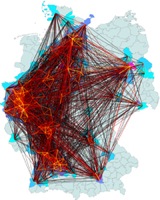Travel Bugs, Geocaching and European Traffic Networks

In this project we investigate the behavior of over dog tagged items known as travel bugs. In order to understand what travel bugs are one first needs to be familiar with Geo-Caching. We quote from Wikipedia:
"Geocaching is an outdoor treasure-hunting game in which the participants use a Global Positioning System (GPS) receiver or other navigational techniques to hide and seek containers (called "geocaches" or "caches") anywhere in the world. A typical cache is a small waterproof container containing a logbook and "treasure", usually toys or trinkets of little monetary value...."
In another article one finds a concise definition of Travel Bugs:
"A Travel Bug is a registered trademark of Groundspeak, Inc. used to describe a dogtag used in Geocaching. It is moved from cache to cache, and its travels can be logged on the geocaching website (www.geocaching.com). Each travel bug tag is printed with a unique PIN, which is needed to post a log online. Some tags are fastened to an object, such as a plastic figurine, before they are let loose."
At the moment nearly a million active travel bugs are circulating worldwide within a network of nearly half a million geocaches in more than 200 countries.
The idea of this project is in spirit similar to the concept underlying our discovery of scaling laws in human travel. The intention is to use the flux of travel bugs as a proxy for the global network of human travel. Unlike in our previous study this project is not confined to the United States.